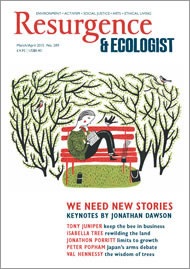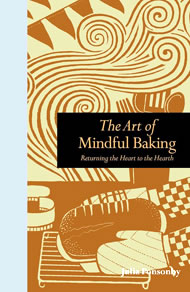Being open to possibilities you have not anticipated is one of the first glorious rules of a mindful approach to life. Resistance to this is perfectly natural – we all resist change in our attempt to maintain a sense of balance in our lives. And so it was, when Satish Kumar directed Monica Perdoni of Leaping Hare Press to get in touch with me about a book on mindful baking, that my first reaction was, “Sorry, but I’m much too busy finishing Gaia’s Feasts” (a second vegetarian cookbook for Schumacher College). Despite writing an email saying I couldn’t possibly write such a book in the next six months and suggesting various other people who possibly could, I nonetheless heard a little voice in my head whispering “but it is a very good idea…”
Monica plied me with other mindfulness books that arrived through the post, covering a range of subjects including mindful walking, cycling, gardening and even beekeeping… I read some and lent others out to friends and to Stephan, my husband – who, as a great walker himself, loved The Art of Mindful Walking by Adam Ford. For me, reading The Art of Mindful Gardening by Ark Redwood, head gardener at the Chalice Well gardens in Glastonbury, was a journey into a gardener’s mind.
This seemed to be a considered approach to life, involving subtle judgements drawing in variables from all around – judgements similar to (but different from) those experienced in my own domain as a cook.
I realised how much the mindful approach already affected my baking, although it was a long time since I had engaged in regular meditation and a long time since I’d first read Thich Nhat Hanh’s Miracle of Mindfulness. Perhaps it is a testament to mindfulness that once you grasp this approach it stays with you even when the vicissitudes of everyday life seem to take over. Getting my son up and off to school in the morning, cooking at the college, placing orders, attending meetings, doing the washing, and so on had become the noise of my existence to such an extent that I wasn’t hearing the background melodies of mindfulness that were still there waltzing me through the long daily routine.
Anyway, to cut a long story short, Monica then offered me an extended deadline that gave me the impression I could dovetail the finishing of Gaia’s Feasts with the beginning of Mindful Baking. In practice, Gaia’s Feasts was delayed twice more and I ended up dealing with a bottleneck of proofreading and two books coming out within a month of each other!
Looking back on the emergence of The Art of Mindful Baking, I see myself as engaging in a learning journey, part leading, part led. The editors, Monica and Jayne, would often email me newspaper snippets about artisan bakers or new domains in which mindfulness was being applied. I had the joy of reading again and listening again (as well as for the first time) to many online lectures from the world of health, wellbeing and baking. I got to update my acquaintance with the Slow Food movement, the Real Bread Campaign and the local food movement. I also got to bake and perfect 19 recipes, many of which had overflowed from Gaia’s Feasts, a book that over its many years of gestation had become too big for its binding.
The Art of Mindful Baking is a book that uses baking bread and other oven-bakes as a vehicle for bringing more mindfulness into your everyday life. It can be dipped into or, better still, approached as a journey with little baking and thoughtfulness projects along the way. In keeping with the rest of Leaping Hare’s mindfulness series, there are no photos – you will have to read each recipe carefully and imagine the results carefully too, until you see them emerging from your own oven in full colour 3D! In these pages you will find a reminder of the basics of mindful living, a history of baking, and an encouragement to be considerate about your ingredients. You will also find an invitation to use – and really appreciate – your wonderful hands, and to connect with wellbeing (your own and other people’s). If inspired, you can use this book as a springboard to launch off into further baking projects using the resources list, which gives the name of some key artisan bread books and baking schools. I hope that anyone who opens this short book will enjoy reading it as much as I’ve enjoyed writing and baking it into being!








